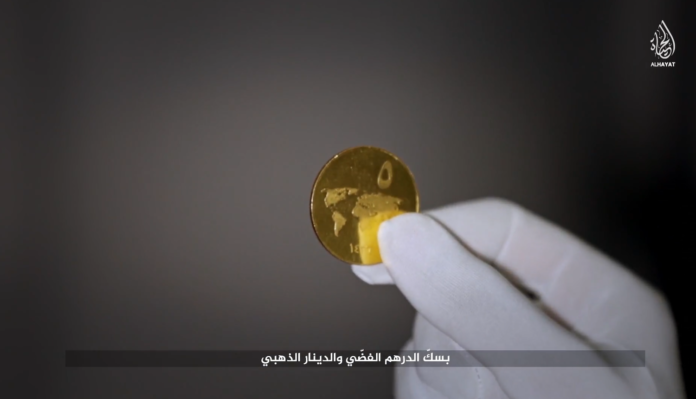[ad_1]
Rachel-Rose O’Leary is a reporter at CoinDesk covering how cryptocurrencies are used in areas of economic, social and political unrest. This article is part of her series from Rojava, Syria.
As Islamic State (ISIS) sought to dominate large parts of Syria and Iraq, it used a subtle weapon to go with the car bombs and suicide attacks: money.
The self-declared caliphate aimed to unify the world under a militant interpretation of Islam. It created a highly efficient, hyper-violent society inside Iraq and Syria, coupled with an economic experiment – what I call “ISIS-coin.”
Consisting of 10 coins ranging in value from nearly a thousand dollars to pennies, ISIS sought to replace US, Iraqi and Syrian banknotes with purpose-built coins backed by the gold, silver and copper standard.
At the time, ISIS was sitting on 34,000 square miles of oil-rich territory. By trading oil using its own currency, the dinar, ISIS planned to destabilize the US economy by forcibly decoupling the dollar from the oil business. (The petro-dollar system, which ISIS refers to as America’s “Achilles heel.”)
The dinar were modeled on coinage from a medieval Islamic empire named the Umayyad Caliphate, the leader of which – a man named Abd al-Malik ibn Marwan – issued coins to economically connect Muslims who were scattered across the Middle East.
In 2015, the dinar was made compulsory for civilians living under ISIS control. At its peak, ISIS controlled 10 million people across Iraq and Syria – making the ISIS dinar among the most ambitious economic experiments in modern history.
While living in the autonomous Rojava, in northern Syria, I met with an ISIS prisoner, Mohammed Najjar, in a facility operated by the Syrian Democratic Forces in Northern Syria. Najjar refused to be photographed or filmed. He was nervous about my sound recorder, and asked me not to publish his name for fear of repercussions from the jihadist group (Mohammed Najjar is a pseudonym).
Najjar worked in oil: ISIS’s most lucrative export and the heart of the dinar experiment. He laughed as I placed a silver durham down on the table in front of him. It’s a wide coin, about a centimeter in diameter. I is decorated with Arabic calligraphy – a verse from the Hadith that praises hard work and charity.
“In Islamic State, this was a failure,” he said, grinning, “It didn’t work.”
In a 2015 propaganda film announcing its release, called the ‘The Return of the Gold Dinar,’ ISIS’s monetary experiment is described as a sequel to the 2001 attacks on the World Trade Center – and a new weapon in an all-out war against the US economy.
“You’ve seen the documentary, right?” Najjar asks with a twinkle in his eye. “The plan was to destroy the global economy.”
The sales pitch
Najjar joined ISIS in October 2013, months after its formation.
With a background in petroleum studies, he spent his days working among oil fields, the heart of ISIS’s economic strategy.
Controlling many oil-rich areas in Iraq and Syria, ISIS had a lucrative business in selling oil to neighboring clients, including Damascus, the Iraqi government, and Turkish-backed rebels, which, according to my source, would then smuggle the oil into Turkey.
“It was the boom,” Najjar said, “Islamic State was making about $60 million a month.”
The problem for ISIS was that all that trade was executed in US dollars. So in spite of the group’s declared war on US hegemony, its economy was actually facilitating US dollar dominance.
Enter the dinar – or, as ISIS propaganda describes it: “the return of the ultimate measure of wealth for the world: gold – as the [caliphate] surges into the financial sphere.”
First, it was introduced in the oil sector – ISIS’s most lucrative export. To buy oil from ISIS, countries had to exchange their dollars for dinar.
ISIS then introduced the dinar to civilians within the Islamic State, slowly at first, with merchants giving change in the new dinar as opposed to banknotes.
By late 2015, the currency became compulsory. “It was prohibited to use the Syrian government currency. It was prohibited to use anything other than the ISIS dinar in all the Islamic State areas,” Najjar said.
The Islamic State was littered with exchanges, he explained, which would swap ISIS dinar for dollars and other currencies, allowing people and businesses to trade with one another.
This came with other advantages for the Islamic State.
While the market price for a 4.25 gram gold dinar was around $160, according to Najjar, it could retail locally at $190. That meant a profit of $30 per dinar for ISIS: a colossal sum when its oil trade was peaking at 150,000 barrels a day.
 ISIS member shows gold dinar to a shopkeeper, ‘Return of the Gold Dinar’ propaganda video
ISIS member shows gold dinar to a shopkeeper, ‘Return of the Gold Dinar’ propaganda videoGold bugs
The ISIS dinar wasn’t just a money grab.
It was also an attempt to create an economy based on Islamic principles. And that’s because, in Sharia law – the religious legal code underpinning Islam – certain kinds of economic practices are forbidden.
Sharia puts a ban on interest – what is called riba – which, according to some interpretations, rules out many conventional banking practices. Certain kinds of debt are also forbidden, because transactions must be backed by an underlying asset, like gold.
The dinar experiment had its roots in the teachings of Islamic scholars such as Sayyid Abdil A’la Mawdudi, who proposed a middle-ground alternative to capitalism and communism, and emphasized the importance of zakat, or charity. ISIS’s unique interpretation of zakat allowed them to fund much of their state-building effort through the contributions of civilians.
The New York Times reported that this tax formed the basis of the ISIS economy, stating that profit from zakat far outweighed oil sales.
But Najjar vehemently denied this point, calling it “lies” and stating that the people in ISIS occupied territories were too poor to contribute in any meaningful way.
That’s notable because, in propaganda, ISIS describes conventional banking practices as “satanic,” and proposes the dinar as an antidote to the “fraudulent and riba-based financial system of enslavement orchestrated by the Federal Reserve in America.”
US thinkers, such as noted goldbug Mike Maloney, conspiracy theorist Edward Griffin and libertarian politician Ron Paul are quoted directly in ISIS propaganda. In rhetoric not unfamiliar to bitcoin enthusiasts, the thinkers criticize the inflation of the US dollar, the abandonment of the gold standard, and the dominance of the dollar globally.
“The US is playing a game in controlling the world by using the dollars,” Najjar said. “Oil you have to buy using dollars. Internationally you have to buy everything using dollars. The dinar was more Islamic. Dinar has a real value, gold has a real value.”
Why it failed
Despite the successful launch of the dinar, ISIS remained vulnerable to economic attack. When, in 2016, the US began a bombing campaign against ISIS’s oil fields, the so-called state began to crumble because it was cut off from its most lucrative resources.
Najjar says the dinar worked better as a means of exchange in the oil industry than an everyday currency for ISIS residents and businesses.
“We used to get it in dollars. Then they changed it to the dinar and that’s when the problems started. Traders stopped bringing in products because they noticed the dinar was not working, so they started retreating from it,” he said.
With demand non-existent outside of the Islamic State, the currency began to exchange for less than it cost to produce.
“The problem was always in buying products. The value of the silver dinar in particular was so low. So when you go to a trader to buy anything they won’t accept this, they say ah, we’re not accepting this. Or he put the price higher,” Najjar said.
Because of its weight – the largest coin is worth nearly a thousand dollars at the time of writing – the gold dinar were coveted by traders, and were often melted down or resold on the market, effectively draining out the gold-based economy.
Not quite bitcoin
Given the restrictions of a Sharia-compliant financial system, including the prohibition on riba, cryptocurrencies have been touted as potential alternatives.
CoinDesk recently reported that the Ethereum Foundation, the non-profit that oversees the management of the ethereum platform, was courting investors from Wahhabist Saudi Arabia, for example.
But Najjar said that, while he had “heard of bitcoin,” he never heard of it being used by ISIS.
A SDF intelligence official confirmed that ISIS was dependent on the US dollar for international trade. Other terror organizations have experimented extensively with crypto.
ISIS lost its last territory to US-backed SDF forces in May. At the time, US forces are said to have collected some $2.1 billion worth of gold – and intelligence officials are hoping to discover more.
“Whenever I go to an interview like this they ask me ‘where is the gold? Where is ISIS hiding it?’” Najjar laughed.
In North Syria, the dinar has fallen out of circulation. Some are passed around between SDF fighters as war trophies. These are mostly copper and silver – the more expensive currencies like the gold dinar have largely been melted down. Reselling the currency is illegal and those in circulation are seized by authorities, aside from a handful kept as souvenirs.
According to Najjar, the failure of the dinar – and Islamic State more broadly – was because it failed to implement Sharia correctly.
“Islam says take from the rich and give it to the poor,” he said, “It was not properly done. It was not implemented properly, it wouldn’t fall. I see it like this.”
Images from ‘Return of the Gold Dinar’
[ad_2]











